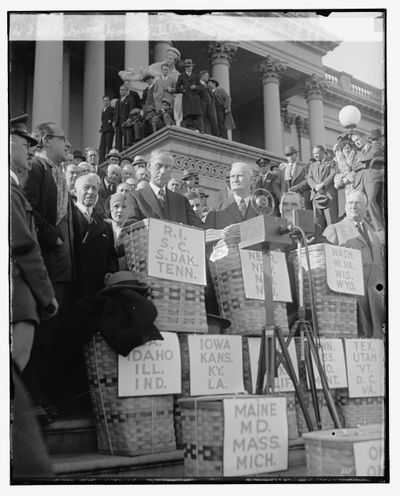Trump tariffs conjure specter of Smoot-Hawley Act, a Depression-era blunder

In the spring of 1930, more than 1,000 economists across the United States wrote a letter urging President Herbert Hoover to veto a tariff bill under consideration by the Senate. The bill “would be a mistake,” they said. It would hurt exporters during a severe recession (that would later be known as the Great Depression) and provoke other countries to enact their own tariffs, they wrote.
But the Smoot-Hawley Tariff Act - named after its Republican authors, Sen. Reed Smoot of Utah and Rep. Willis C. Hawley of Oregon - became law on June 17, 1930, when Hoover signed the bill. Paul H. Douglas, a future senator who was then an economics professor at the University of Chicago and a signatory to the letter against the act, lamented that “all our predictions came true.”
Now, as President Donald Trump seeks to enforce steep, blanket tariffs, the Smoot-Hawley bill offers a cautionary tale of the detriments of protectionist barriers that result in trade wars, many economists say.
“No one wins from trade wars,” Kris Mitchener, a professor of economics at Santa Clara University who has studied the effects of the Smoot-Hawley tariffs, said in an email. “They are costly to all combatants.”
Trump has said tariffs will incentivize corporations to bring back factories to the U.S. from abroad to avoid the duties. He imposed tariffs on Mexico and Canada in March - only to delay them, then announce tariffs on a global scale this month, before indicating in remarks last week that he is open to negotiations with individual countries that could dial the tariffs back down.
That “whipsawing of tariff policy” is creating stock market volatility, as it did during the 1929-1930 period, before the passage of the Smoot-Hawley bill, as lawmakers debated which goods should be subject to new tariffs, Mitchener said. “Companies … need clarity to decide where to locate their manufacturing and their supply-chain investments.”
The Smoot-Hawley tariff on average raised import duties by 15 percent on hundreds of goods, according to an estimate by Douglas Irwin, professor of economics at Dartmouth College. The Great Depression, which deflated prices as consumers and businesses cut spending, raised the de facto duties by an additional 30 percent, according to Irwin’s calculation.
Originally intended by Republicans to assist struggling farmers, the Smoot-Hawley Tariff Act was expanded to cover the interests of a motley group of industries as it was shepherded through Congress. It earned “eternal notoriety as an ill-timed piece of legislation that reflected special-interest logrolling run amok,” Irwin wrote in his 2017 book, “Clashing Over Commerce: A History of US Trade Policy.”
Trump has described the Smoot-Hawley tariff as a belated attempt to save the U.S. economy from the Depression, which could have worked had it been rolled out earlier. The assertion hasn’t won over too many economists, many of whom say the tariff didn’t help because it stifled global trade.
It took just a few years for the Smoot-Hawley tariff to worsen the Depression.
U.S. exports shriveled to a third of their pre-Smoot-Hawley levels, according to the State Department, as the taxes prompted European countries to impose retaliatory tariffs. World trade declined by some 66 percent from 1929 to 1934, according to the State Department.
Reflecting the growing pessimism about the state of the U.S. and global economies, the Dow Jones Industrial Average sank from around 220 points in June 1930 to below 50 points by June 1932. It wasn’t until 1950 that the index climbed back above 220.
“Economists agree that the collapse in trade made the Depression worse,” Mitchener said. “It wasn’t just the Smoot-Hawley tariff war that took place. Countries retreated from open markets, in general, and began to put restrictions on imports across all their trade partners - not just the U.S.”
As the Depression wore on, American voters quickly became disenchanted with the Smoot-Hawley tariff. The Republican Party lost 52 seats in the House in the 1930 midterm elections and 101 more in the 1932 elections.
Smoot, Hawley and Hoover, meanwhile, were all voted out of office in 1932.
It’s unclear whether any farmer or industry benefited from the 1930 Smoot-Hawley tariff, Irwin said. Whatever good that was derived from the tariff was probably “drowned out” by the costs of the tariff, he added.
Trump’s proposed tariffs would have a much larger impact than that of the Smoot-Hawley Tariff Act on the U.S. and global economies, economists said.
“Trade is a larger proportion of GDP today, while there are far more intermediate goods,” Irwin said in a phone interview.
Exports accounted for about 11 percent of the U.S. gross domestic product in 2023, according to the World Bank. In 1929, exports accounted for 5 percent.
Mitchener noted that Trump’s proposed increases would also be much larger than the hike in 1930 because Trump’s rate would raise the average tariff from about 2 percent to 24 percent. Under Smoot-Hawley, the average tariff rate climbed from 36 percent to 41 percent, Mitchener said.
“If major trade partners retaliate with similar tariffs as implied by the reciprocal tariffs … the effects on global trade flows would be quite large,” Mitchener said. “But it remains to be seen whether the Trump administration is using tariffs as a negotiating tool.”